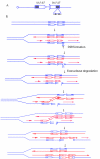Effects of mutations in SGS1 and in genes functionally related to SGS1 on inverted repeat-stimulated spontaneous unequal sister-chromatid exchange in yeast
- PMID: 18166135
- PMCID: PMC2254439
- DOI: 10.1186/1471-2199-8-120
Effects of mutations in SGS1 and in genes functionally related to SGS1 on inverted repeat-stimulated spontaneous unequal sister-chromatid exchange in yeast
Abstract
Background: The presence of inverted repeats (IRs) in DNA poses an obstacle to the normal progression of the DNA replication machinery, because these sequences can form secondary structures ahead of the replication fork. A failure to process and to restart the stalled replication machinery can lead to the loss of genome integrity. Consistently, IRs have been found to be associated with a high level of genome rearrangements, including deletions, translocations, inversions, and a high rate of sister-chromatid exchange (SCE). The RecQ helicase Sgs1, in Saccharomyces cerevisiae, is believed to act on stalled replication forks. To determine the role of Sgs1 when the replication machinery stalls at the secondary structure, we measured the rates of IR-associated and non-IR-associated spontaneous unequal SCE events in the sgs1 mutant, and in strains bearing mutations in genes that are functionally related to SGS1.
Results: The rate of SCE in sgs1 cells for both IR and non-IR-containing substrates was higher than the rate in the wild-type background. The srs2 and mus81 mutations had modest effects, compared to sgs1. The exo1 mutation increased SCE rates for both substrates. The sgs1 exo1 double mutant exhibited synergistic effects on spontaneous SCE. The IR-associated SCE events in sgs1 cells were partially MSH2-dependent.
Conclusions: These results suggest that Sgs1 suppresses spontaneous unequal SCE, and SGS1 and EXO1 regulate spontaneous SCE by independent mechanisms. The mismatch repair proteins, in contradistinction to their roles in mutation avoidance, promote secondary structure-associated genetic instability.
Figures

Similar articles
-
Inverted repeat-stimulated sister-chromatid exchange events are RAD1-independent but reduced in a msh2 mutant.Nucleic Acids Res. 2005 Sep 15;33(16):5243-9. doi: 10.1093/nar/gki835. Print 2005. Nucleic Acids Res. 2005. PMID: 16166656 Free PMC article.
-
The hyper unequal sister chromatid recombination in an sgs1 mutant of budding yeast requires MSH2.DNA Repair (Amst). 2004 Oct 5;3(10):1355-62. doi: 10.1016/j.dnarep.2004.05.008. DNA Repair (Amst). 2004. PMID: 15336630
-
Both CAG repeats and inverted DNA repeats stimulate spontaneous unequal sister-chromatid exchange in Saccharomyces cerevisiae.Nucleic Acids Res. 2004 Oct 19;32(18):5677-84. doi: 10.1093/nar/gkh901. Print 2004. Nucleic Acids Res. 2004. PMID: 15494455 Free PMC article.
-
Yeast as a model system to study RecQ helicase function.DNA Repair (Amst). 2010 Mar 2;9(3):303-14. doi: 10.1016/j.dnarep.2009.12.007. Epub 2010 Jan 13. DNA Repair (Amst). 2010. PMID: 20071248 Review.
-
Maintenance of Yeast Genome Integrity by RecQ Family DNA Helicases.Genes (Basel). 2020 Feb 18;11(2):205. doi: 10.3390/genes11020205. Genes (Basel). 2020. PMID: 32085395 Free PMC article. Review.
Cited by
-
Extensive DNA end processing by exo1 and sgs1 inhibits break-induced replication.PLoS Genet. 2010 Jul 8;6(7):e1001007. doi: 10.1371/journal.pgen.1001007. PLoS Genet. 2010. PMID: 20628570 Free PMC article.
-
Replication stress leads to genome instabilities in Arabidopsis DNA polymerase delta mutants.Plant Cell. 2009 Sep;21(9):2700-14. doi: 10.1105/tpc.109.069682. Epub 2009 Sep 29. Plant Cell. 2009. PMID: 19789281 Free PMC article.
-
DNA end resection: many nucleases make light work.DNA Repair (Amst). 2009 Sep 2;8(9):983-95. doi: 10.1016/j.dnarep.2009.04.017. Epub 2009 May 26. DNA Repair (Amst). 2009. PMID: 19473888 Free PMC article. Review.
-
Both RAD5-dependent and independent pathways are involved in DNA damage-associated sister chromatid exchange in budding yeast.AIMS Genet. 2017;4(2):84-102. doi: 10.3934/genet.2017.2.84. Epub 2017 Mar 30. AIMS Genet. 2017. PMID: 28596989 Free PMC article.
References
-
- Rothstein R, Michel B, Gangloff S. Replication fork pausing and recombination or "gimme a break". Genes Dev. 2000;14:1–10. - PubMed
-
- Nakayama H, Nakayama K, Nakayama R, Irino N, Nakayama Y, Hanawalt PC. Isolation and genetic characterization of thymineless death resistant mutant of Escherichia coli K12: identification of a new mutation (recQ1) that blocks the RecF pathway. Mol Gen Genet. 1984;195:474–480. doi: 10.1007/BF00341449. - DOI - PubMed
MeSH terms
Substances
LinkOut - more resources
Full Text Sources
Molecular Biology Databases

